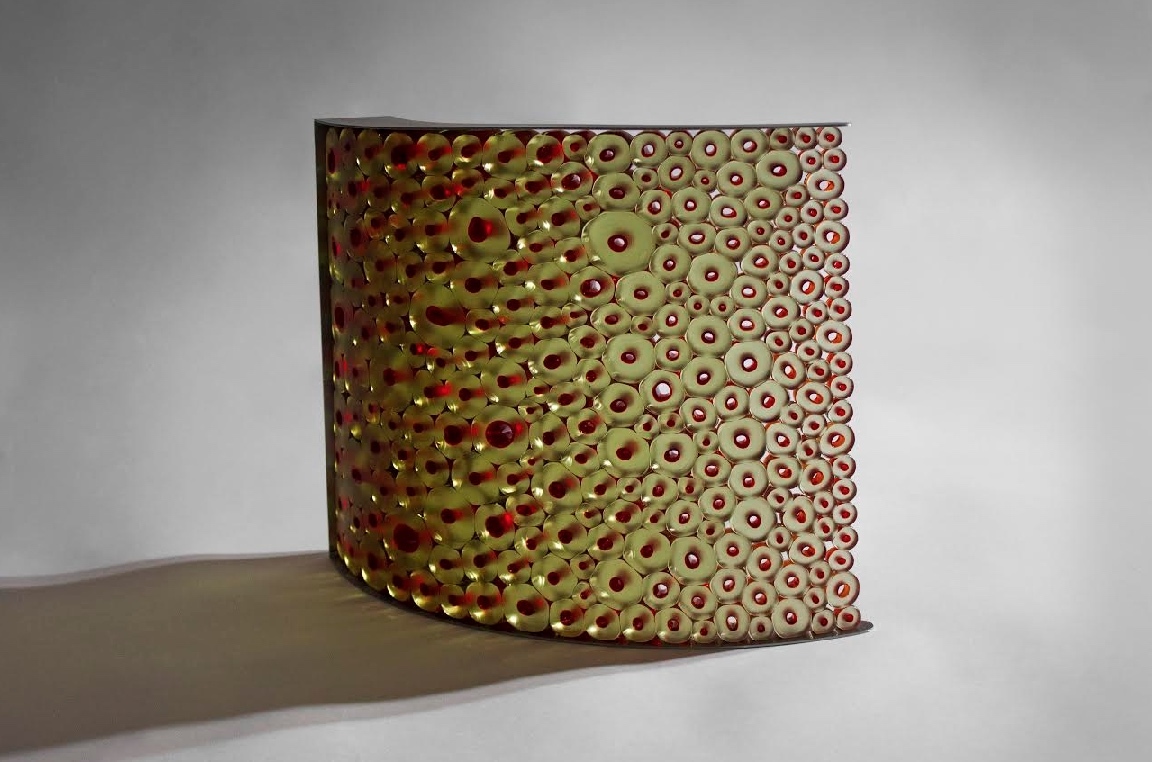Through July 15th, Australia-based artist Matthew Curtis is showcasing his latest body of work in the exhibit "Matthew Curtis: Intersect" at LewAllen Galleries in Santa Fe. The Glass Quarterly Hot Sheet asked him him a few questions about how his work has been developing, what it's been like to exhibit internationally, and where he sees himself going from from here.
Glass Quarterly Hot Sheet: Does the work in this exhibition represent a new direction for you?
Matthew Curtis: This work signifies a subtle shift in my use of the material. It is a continuation in exploring the blown glass bubble, in slicing these elements and compiling them into fields of components. These are then fused together, creating a plane of glass, reminiscent of the cross section of the internal structure of organic growth. So there are similarities in both narrative and structure, yet I have been able to work with more abstracted color fields.
Glass: How do you locate this work in your larger oeuvre?
Curtis: I feel this work fits within the breadth of my practice. Although I continue to approach the material differently, there are recurring themes within my practice. There is also an aesthetic concerned with how structures are formed which infuses my work. I continue to use multiple components brought together. Making glass elements, blown cast and fused, where the orientation is changed, or cross section is sliced. Within these components, there are subtle differences. When these are brought together to make a larger whole, the intricate differences create their own rhythm. The components fit together sympathetically, accommodating the smaller details within the larger structure. This is part of my practice which is integral, even when I use the glass differently or use different materials.

Glass: Have you noticed any differences between showing at a glass gallery versus a gallery that shows a wider variety of media? Do you get different questions from the gallery? From gallery-goers who look at the work?
Curtis: I am fortunate to have shown now for many years at SOFA Chicago, and feel that those conversations with collectors and artists in other media, provide excellent opportunities to discuss broader themes about form and concept rather than technique. I am very interested to meet some of the clients of Lew Allen Gallery, and hopefully some local artists. I have really enjoyed working with Robert Gardener over the years, and I am so impressed with the gallery space, and the knowledge of the staff. I hope to have ranging conversations, maybe about the incredible quality of light in Santa Fe during my visit.
Glass: Do you expect anything different from your shows at Sabbia Gallery in your home country of Australia versus a show in Santa Fe?
Curtis: Working with varied galleries and exhibiting in differing spaces gives you the opportunity to view your work differently. At times the costs of shipping does unintentionally inform the work that gets sent overseas. Sabbia, like my international galleries, deals with museum quality work so the finish and detail whether larger or smaller is important. The galleries usually are supportive of any concepts and themes I wish to work with. Also, the incarnation or developments in my practice are also supported. In early 2017 I had an exhibition with my partner, Harriet Schwarzrock, at the Canberra Glassworks in conjunction with the Ausglass conference. This gave me the incredible opportunity to work on a larger project for the foyer of the Glassworks, as it's a short drive from my home/studio. The Arc piece comprised of hundreds of plaster components with transparent glass tubes within the hexagonal forms. These were then built into a frame, to create a large curved wall-like structure. A dynamic larger work, with glass details to let light perforate the space. In effect being a local project allowed me to work on this different scale.

Glass: Where do you see yourself going from here — what kind of work are you currently working on or looking to create, and what kinds of topics and ideas are you interested in at the moment?
Curtis: I'm so fortunate to have the support of local patrons of the arts in Canberra in John and Rosanna Hindmarsh. They are facilitating a public sculpture, a project which will see glass in the details within a larger metal structure. Although I have pangs of anxiety about the project, I'm excited to be working in a different way and working differently with space. I also have gallery commitments, having been invigorated by some of these new works in the Intersect exhibition at Lew Allen Gallery. I look forward to further working with these cross section pieces. Especially with abstracting the elements and creating tension and harmony within the forms. Although all this is plenty to keep me occupied, I've been inspired to make larger works again along the lines of the Arc installation at the Canberra Glassworks. Rather than being constrained by shipping (as my boys are now young men), I'm considering varied approaches to make these over life-sized works. Possibly looking at creating the next generation of this work within a residency in the States and then showing it afterwards. Like always, I've got many projects and ideas jostling for attention. I continue to be inspired by the form and structure of the architecture of organic growth, and the puzzle of envisaging and creating these abstractions within my work.



